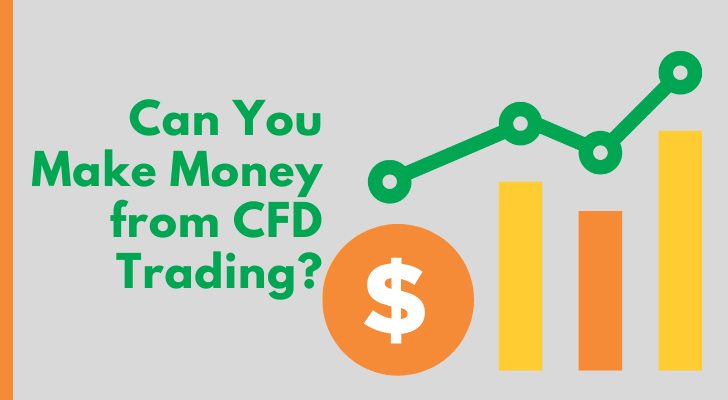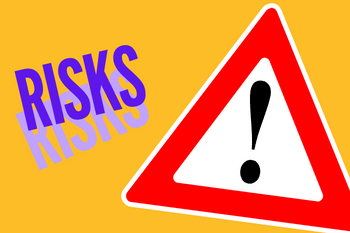CFD trading is a popular form of online trading that allows users to speculate on the price movements of financial assets. Many people view CFD trading as being too risky to warrant a full-time income from it. However, the truth is that any form of trading comes with its own risks. So the real question is, can you actually make a full-time income from CFD trading? And if so, what does it take to become a professional CFD trader?
What is CFD trading?
CFD (Contract for Difference) trading is a popular way to speculate on financial markets. A CFD is an agreement between two parties to exchange the difference in the value of an underlying asset at the end of a contract period.
CFDs are traded on leverage, meaning you can put down a small deposit and control a much larger position. This can magnify profits – but also losses.
CFD trading involves predicting whether the price of an asset will go up or down. If you believe the price will rise, you choose to ‘buy’, and if you believe it will fall, you choose to ‘sell’. When the contract period ends, if your prediction was correct, you make a profit. If not, you incur a loss.
You can trade CFDs on a wide range of assets including shares, indices, commodities, forex and more.
How Does CFD Trading Work?
CFD, or contract for difference, trading is a type of derivative trading that allows you to speculate on the price movement of an underlying asset without actually owning the asset. CFDs are traded on margin, meaning you only need to put down a small deposit – or margin – to open a position. This makes CFD trading accessible to investors with smaller budgets.
When you trade CFDs, you’re essentially betting on the price movement of an underlying asset. If you think the price of an asset will go up, you can buy a CFD (known as going long). If you think the price will fall, you can sell a CFD (going short).
CFD trading is similar to traditional trading in some ways, but there are also some key differences. For one, when you trade CFDs your profit or loss is based on the full value of the contract, not just the amount you put down as collateral. This means that profits (or losses) can be much larger than your initial investment.
Another key difference is that with traditional trading you usually need to wait until the end of the day or week to see how your trades have performed. With CFDs, however, prices are constantly fluctuating so you can see your profits and losses instantly. This also means that it’s possible to make money even when markets are falling – something that’s not possible with traditional investing.
The Potential Rewards of CFD Trading
When it comes to CFD trading, the potential rewards are significant. With leverage, traders can magnify their returns on investment. And, because CFDs are traded on margin, traders can get full exposure to the underlying asset with a small amount of capital.
Additionally, CFDs offer traders the opportunity to short-sell – meaning they can profit from falling prices as well as rising prices. This is something that isn’t possible with traditional investing.
Finally, CFDs typically have low costs associated with them. This includes things like spreads and commissions, which can eat into profits.
What are the Risks of CFD Trading?
When engaging in CFD trading, it is important to be aware of the risks involved. Some of the risks associated with CFD trading include:
1. The potential for loss:
Due to the leverage involved in CFD trading, there is a possibility of losing more money than what is initially deposited into the account. It is important to only trade with money that you can afford to lose.
2. The volatile nature of markets:
Markets can be highly volatile, which can result in rapid and substantial losses. It is therefore important to have a risk management strategy in place before entering into any trades.
3. Counterparty risk:
When entering into a contract with another party, there is always a risk that they will not fulfill their obligations. This could lead to losses for the trader.
4. Regulatory risk:
Changes in regulations can impact the profitability of CFD trades. It is therefore important to keep up-to-date with any changes that may occur.
5. Liquidity risk:
Low liquidity levels can make it difficult to exit a trade at a desired price, which could lead to losses.
How to Minimise the Risks of CFD Trading
CFD trading is a high-risk investment and is not suitable for everyone. Before you start trading, you should consider your investment objectives, level of experience and risk appetite. You should also be aware of the potential for losses in excess of your initial deposit.
To minimise the risks of CFD trading, you should:
- Manage your leverage - don't trade with more leverage than you can afford to lose.
- Use stop-loss orders - these will help limit your losses if the market moves against you.
- Monitor your positions - keep an eye on your open positions and don't let them run too far into the red.
- Review your trades - after each trade, take some time to review what happened and why. This will help you learn from your mistakes and improve your future trading performance.
Is CFD Trading Right For You?
Ultimately, the decision comes down to your own personal circumstances and risk tolerance. That said, there are a few key things to keep in mind that may help you make the decision.
- CFD trading is a leveraged product, meaning you can control a large position with a relatively small amount of capital. This can magnify both your profits and losses, so it's important to be aware of the risks involved before you get started.
- CFDs are traded on margin, so you'll need to have enough funds in your account to cover any potential losses. This means that even if the market moves against you by a small amount, you could still end up losing money.
- It's worth considering whether you have the time and patience to effectively trade CFDs. Unlike other investment products, such as shares or managed funds, CFDs require active management and frequent monitoring. If you're not prepared to do this, then CFD trading may not be right for you.
How to Start CFD Trading
When it comes to online trading, contracts for differences (CFDs) are one of the most popular instruments. A CFD is an agreement between two parties to exchange the difference in the value of a financial instrument between the time the contract is opened and when it’s closed. In other words, you speculate on whether an asset’s price will go up or down without actually owning the underlying asset.
If you think a market will rise, you open a ‘buy’ CFD. If you think it will fall, you open a ‘sell’ CFD. It’s that simple. You don’t need to have huge amounts of capital to trade – with leverage, you can control much larger positions than your deposit. And because you only pay (or receive) the interest on your position overnight, leveraged trading can be extremely cost-effective.
Now let’s look at how to start CFD trading step by step:
Step 1: Find a reputable broker
There are many brokers out there and finding a reputable one is essential for your success as a trader. To help narrow down your search, make sure your chosen broker is regulated by a major financial body such as the Financial Conduct Authority (FCA) in the UK, CySEC in Cyprus or ASIC in Australia.
Step 2: Open an account
Once you’ve found a broker that meets your needs, you can open an account in a few simple steps. The process will vary slightly from broker to broker but will generally involve providing some personal information and proof of ID, such as a passport or driving licence.
Step 3: Deposit funds
Obviously, your account must be funded before you can begin trading. Most brokers offer a variety of deposit methods, including credit and debit cards, bank transfers and e-wallets such as PayPal or Skrill.
Step 4: Choose your CFD
Now it’s time to start trading! When choosing a CFD, you’ll first need to decide which asset you want to trade.
There are hundreds of different markets available, from major indices like the FTSE 100 or S&P 500 to commodities like gold or oil, and even individual shares such as Apple or Barclays.
Next, you’ll need to choose your position size. This is the number of CFDs you want to trade. Most brokers will allow you to trade in sizes of 1, 10 or even 100 CFDs.
Finally, you’ll need to set your leverage. Leverage is a feature that allows you to control a larger position than your deposit. For example, if you have a £1,000 deposit and you set your leverage at 1:100, you could trade a position worth up to £100,000.
Step 5: Place your trade
Once you’ve decided on your CFD, it’s time to place your trade. Most brokers offer a trading platform that allows you to buy and sell CFDs with just a few clicks. Simply enter the asset you want to trade, the number of CFDs and your desired leverage, then click ‘buy’ or ‘sell’.
Practice CFD Trading with a Demo Account
But before you start trading with real money, it's important to practice with a demo account. A demo account lets you trade without risking any of your own money. It's a great way to learn how the markets work and to test out your trading strategies without any financial risk.
Your broker will typically provide you with a set amount of virtual funds to trade with on your demo account. You will need to provide some basic personal information, but no money is required at this point. Once your account is approved, you will be given access to a virtual trading platform, or a simulator, where you can trade CFDs just like you would in the real world.
Once you have funded your account, you can start placing trades using real market data. The prices you see on the platform will be the same as those that are used in the real world, so you can get an accurate idea of how your strategies would perform if you were actually trading with real money.
This may be enough to cover several trades, or it may only be enough for a few. It all depends on the broker and the specific account type that you choose.
If your demo account runs out of funds, you can simply replenish it by contacting your broker. This allows you to keep practising indefinitely until you feel confident enough to start trading with real money.
Alternatives to CFD Trading
If you are looking for alternatives to CFD trading, there are plenty of options available. Here are a few:
1. Trading futures contracts:
Futures contracts are standardized agreements to buy or sell an asset at a future date, at a price agreed upon today. Futures contracts are traded on exchanges, and many brokers offer access to futures markets.
2. Trading forex:
Forex, or foreign exchange, is the market where currencies are traded. Currencies are always traded in pairs, for example, EUR/USD or USD/JPY. Forex is a very liquid market with high leverage, making it an attractive option for traders.
3. Spread betting:
Spread betting is a type of speculation on the financial markets in which you bet on whether the price of an asset will rise or fall. Spread betting is available on a wide range of assets, including shares, indices, currencies and commodities.
4. Investing in cryptocurrency:
Cryptocurrency is a digital or virtual currency that uses cryptography to secure its transactions and to control the creation of new units of the currency. Many brokers now offer trading in cryptocurrencies like Bitcoin and Ethereum.
5. Buying and selling physical gold:
Gold has been used as a form of currency and a store of value for centuries. Today, you can buy and sell gold bars and coins easily online through bullion dealers like GoldMoney, BullionVault, and Augusta Precious Metals.
Conclusion
Many people believe that you can make a lot of money through CFD trading, and while it is true that you can make some money this way, it is also important to remember that there are risks involved. Before making any decisions, be sure to do your research and understand both the potential rewards and risks associated with CFD trading. With this knowledge in hand, you can then make an informed decision about whether or not this type of investment is right for you.




